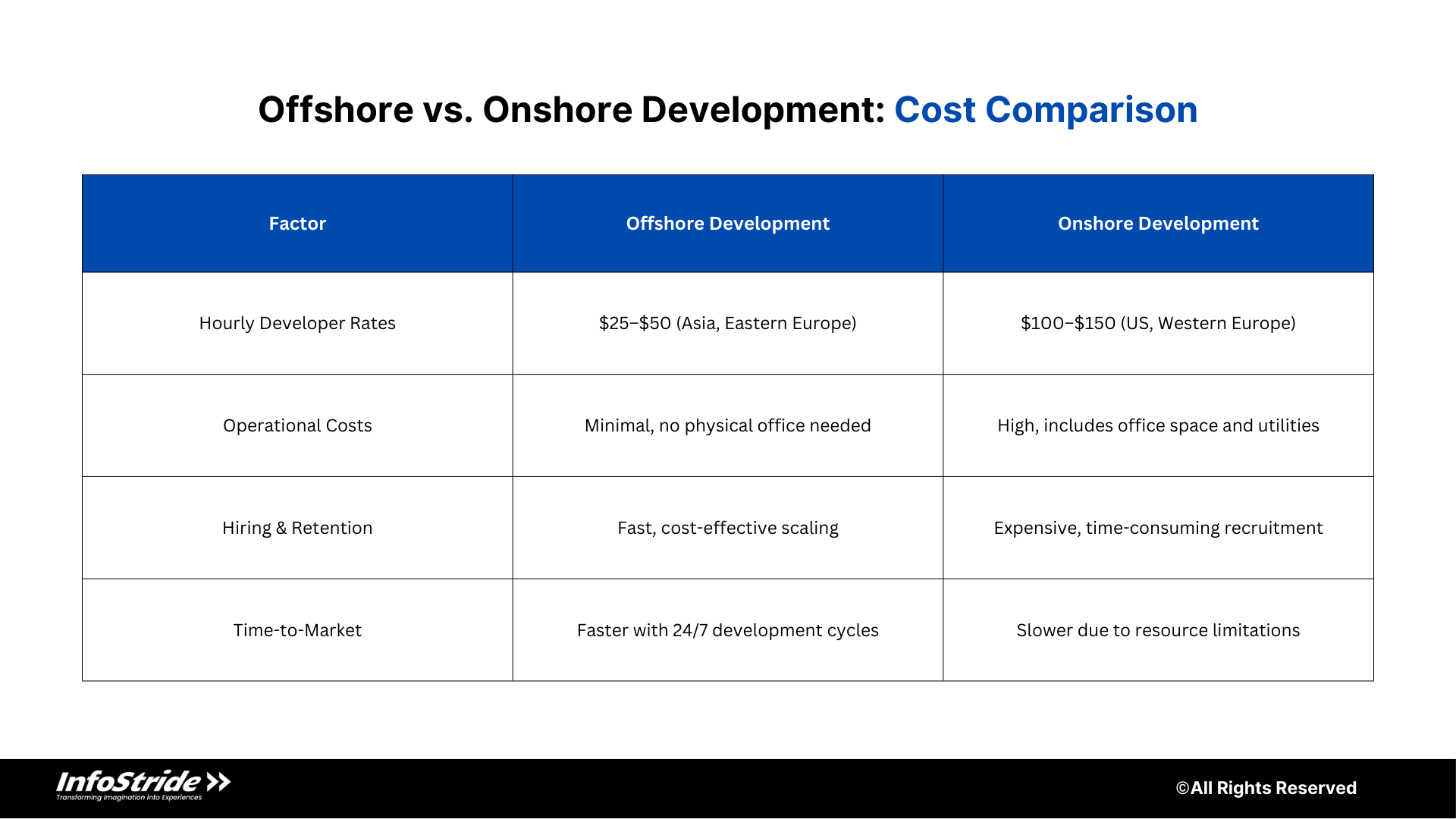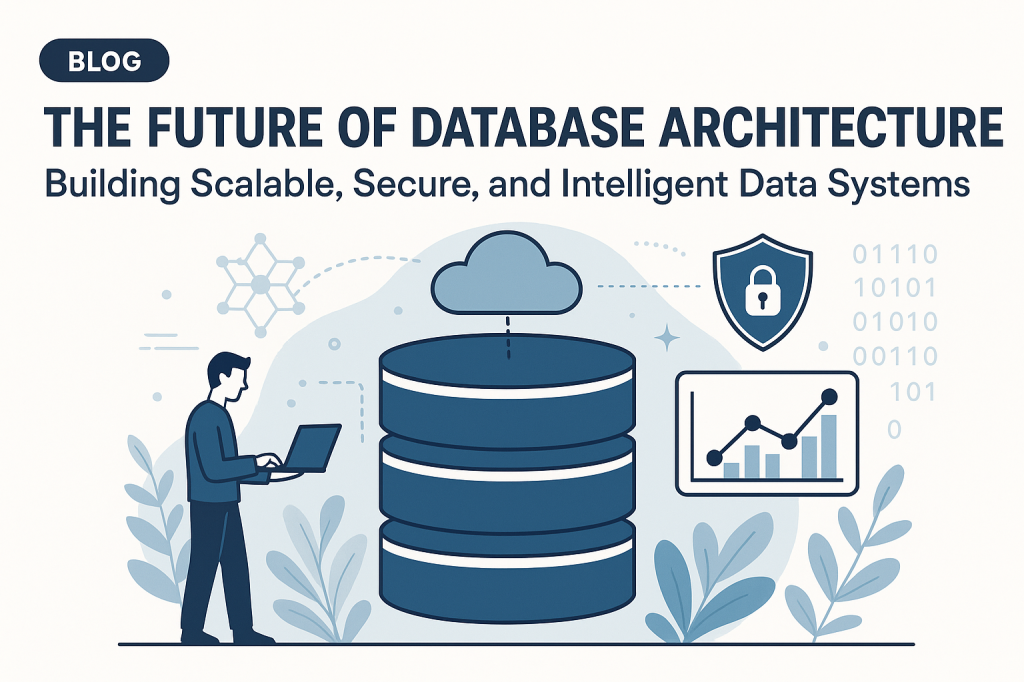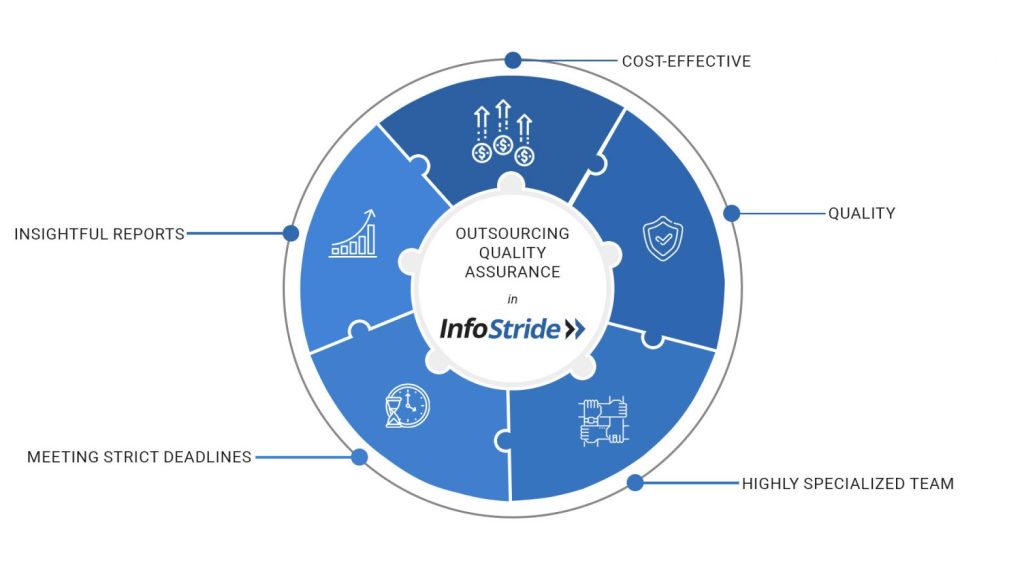Businesses are constantly seeking ways to reduce costs while maintaining high-quality software development. Offshore development has emerged as a strategic solution, enabling companies to tap into a global talent pool at a fraction of the cost of in-house teams. In fact, companies can save up to 70% on development costs by outsourcing to offshore teams, making it a preferred choice for startups and enterprises alike.
Beyond cost savings, offshore development services offer scalability, faster time-to-market, and access to specialized expertise without the overhead of full-time hiring. Whether through dedicated offshore development center or IT staff augmentation services, businesses can optimize resources, enhance productivity, and focus on innovation while their offshore partners handle the technical heavy lifting. This guide explores actionable strategies to maximize cost savings through offshore development, helping businesses make informed decisions.
Offshore Development: A Cost-Effective Strategy for Businesses
Offshore development is the process of outsourcing software development tasks to teams in other countries, typically in regions with lower labor costs. Businesses collaborate with an offshore development company to build, manage, or scale their digital products while minimizing expenses. This approach allows companies to optimize resources, speed up development cycles, and access specialized expertise without the burden of full-time hiring.
Offshore vs. Onshore Development: Cost Comparison
Many businesses weigh the decision between offshore and onshore development, with cost being a major factor. Offshore teams offer significantly lower hourly rates, reduced operational expenses, and access to a global talent pool. In contrast, onshore development comes with higher salaries, infrastructure costs, and longer hiring processes. The table below highlights key differences:

Key Financial Advantages of Offshore Development
Lower Operational Expenses
Offshore development eliminates the need for physical office space, utilities, and other infrastructure costs, making it a highly cost-effective model. Businesses can significantly cut overhead expenses while ensuring seamless remote collaboration through digital communication tools.
Reduced Hiring & Infrastructure Costs
Scaling development teams offshore is far more flexible and affordable than hiring locally. Instead of dealing with lengthy recruitment cycles and high salary expectations, companies can leverage IT staff augmentation services to onboard skilled developers quickly—without long-term commitments or added administrative burdens.
Access to a Global Talent Pool
By outsourcing to offshore hubs like India, Eastern Europe, and Latin America, businesses gain access to experienced professionals skilled in the latest technologies. This ensures high-quality development at a fraction of the cost, allowing companies to maximize their budget while maintaining innovation and efficiency.
Key Strategies to Maximize Cost Savings with Offshore Development
Maximizing cost savings through offshore development requires thoughtful strategies that enhance efficiency while minimizing expenses. Here are the key tactics businesses can use to optimize their offshore partnerships:
A. Choosing the Right Offshore Development Model
Selecting the right offshore development model plays a crucial role in maximizing cost savings.
- Dedicated Offshore Development Center (ODC): An ODC offers a long-term, scalable solution for businesses seeking a dedicated team. It provides a higher level of control and coordination, ensuring consistent project delivery with cost efficiency. [Interlink to ODC services page]
- Project-based Outsourcing vs. IT Staff Augmentation: Project-based outsourcing can be more cost-effective for short-term projects, while IT staff augmentation services are ideal for scaling teams quickly and flexibly based on project demands. [Interlink to IT staff augmentation services page]
B. Selecting the Right Offshore Development Partner
Choosing the right offshore development partner is essential for ensuring a cost-effective collaboration.
- Expertise & Experience: Assess the partner’s ability to handle your project’s complexity and their experience in similar industries. A partner with specialized knowledge will deliver better value and results.
- Pricing Models: Look for flexible pricing models like fixed-price contracts or hourly rates that align with your budget and needs. Ensure there are clear terms regarding scope, deliverables, and timelines.
- Track Record: Evaluate the partner’s past success stories and client testimonials to gauge reliability and trustworthiness. A strong track record of cost-efficient delivery is key to maximizing savings.
C. Optimizing Team Structure & Resource Allocation
How you structure and allocate resources can significantly impact costs.
- Balancing Full-Time vs. Contract Developers: Having a mix of full-time and contract developers can help balance costs while maintaining project momentum. Full-time employees ensure stability, while contract developers bring flexibility for specific tasks.
- Leveraging IT Staff Augmentation Services: By using IT staff augmentation services, businesses can quickly scale their teams without the overhead of long-term hiring commitments, thus optimizing resource allocation.
D. Managing Communication & Productivity for Cost Efficiency
Efficient communication and productive workflows are essential for avoiding costly delays and rework.
- Streamlined Communication Channels: Set up clear and efficient communication methods between your in-house team and offshore partners to reduce misunderstandings and ensure smooth collaboration. Tools like Slack, Microsoft Teams, and video calls are essential for maintaining ongoing dialogue.
- Agile Methodologies: Adopting agile development practices can enhance flexibility and responsiveness, allowing businesses to adjust priorities quickly and efficiently. This reduces unnecessary rework and minimizes costs.
E. Leveraging Technology & Automation
Incorporating technology and automation into your offshore development processes can significantly reduce manual workloads and increase efficiency.
- AI & Automation: By utilizing artificial intelligence (AI) and automation tools, offshore teams can streamline repetitive tasks, optimize workflows, and improve project delivery times—all of which contribute to cost savings.
- DevOps & Cloud Solutions: DevOps practices help streamline development and deployment cycles, while cloud solutions reduce infrastructure costs by providing scalable, on-demand resources. Remote collaboration tools also ensure that teams can work together seamlessly across locations.
Common Cost Pitfalls in Offshore Development & How to Avoid Them
While offshore development offers significant cost savings, businesses must be aware of potential pitfalls that can negate these advantages. By recognizing these common challenges and adopting strategies to mitigate them, companies can ensure a smooth, cost-efficient partnership.
1. Hidden Costs in Offshore Contracts & How to Negotiate Better Terms
One of the biggest challenges in offshore development is hidden costs. These can include:
- Unclear pricing structures: Costs for revisions, project changes, or additional features may not always be clearly defined upfront, leading to unexpected expenses.
- Maintenance and support: Some offshore contracts might not cover ongoing support or future updates, which could result in additional, unforeseen costs.
How to Avoid It:
- Ensure the contract includes clear terms on pricing, including any potential extra costs for revisions or additional services.
- Negotiate fixed-price agreements for clearly defined projects and milestones to avoid fluctuating costs.
- Include detailed clauses for ongoing maintenance and support to ensure predictable future expenses.
2. Over-reliance on Low-Cost Providers Leading to Quality Issues
While the allure of low-cost providers is strong, choosing a provider solely based on price can lead to quality issues and subpar project outcomes. Low-cost options might lack:
- Skilled developers with the required expertise.
- A well-defined development process that ensures the highest quality.
- Sufficient testing and quality assurance (QA) practices.
How to Avoid It:
- Balance cost savings with quality. Consider mid-range pricing providers with a proven track record of delivering high-quality work.
- Ask for developer portfolios and case studies to assess expertise.
- Ensure a thorough QA process is in place to maintain standards across the development lifecycle.
3. Lack of Proper Project Management Leading to Scope Creep & Cost Overruns
Without proper project management, offshore projects can suffer from scope creep (uncontrolled changes or continuous growth of project scope) and cost overruns. Common issues include:
- Lack of clear communication on project goals, timelines, and deliverables.
- Changing requirements or lack of project scope definition.
- Missed deadlines or inefficient allocation of resources.
How to Avoid It:
- Establish clear project goals, timelines, and a well-defined scope from the outset to avoid misunderstandings.
- Use agile methodologies to manage changing requirements without letting them affect the overall project cost or timeline.
- Designate a reliable project manager to oversee timelines, resources, and budgets, ensuring that the project stays on track and within scope.
Case Study: Skype – How Offshore Development Helped Slash Costs and Boost Innovation

Background:
Skype, the popular communication platform, was originally founded in Estonia but grew rapidly across global markets. As the company expanded, they realized the need to scale their development efforts without incurring high domestic costs. They sought an offshore development model to increase their capabilities while reducing expenses.
Offshore Development Strategy:
Skype partnered with offshore development teams based in Estonia and later expanded to countries like Sweden, Russia, and the Ukraine. They combined dedicated offshore development centers with IT staff augmentation to handle various aspects of their software development, including infrastructure management, backend development, and security features.
Cost Savings Achieved:
- Significant Reduction in Development Costs: Skype reduced their overall development costs by over 50% by outsourcing much of their software engineering and backend work to offshore teams.
- Operational Savings: By utilizing offshore centers, they were able to avoid the hefty overhead costs associated with large offices and teams in high-cost regions like the US and Western Europe.
- Scalability & Speed: Offshore teams provided the ability to scale quickly without the need for hiring and training new staff. They also ensured that development was continuous, with teams working around the clock due to time zone differences.
Quantifiable Impact on Success:
- Skype’s partnership with offshore development allowed them to grow rapidly while keeping costs low. By 2005, Skype had over 100 million users, and the company’s ability to expand at a fast pace was partially due to the savings generated from offshore development.
- In 2005, eBay acquired Skype for $2.6 billion, making it one of the most successful case studies of leveraging offshore development for scaling tech innovation and growth. Skype’s ability to cut operational costs while continuously improving their service was a major factor in their valuation and eventual acquisition.
Ready to Take the Next Step?
Offshore development offers a tremendous opportunity for businesses to maximize cost savings while accessing a global talent pool. By choosing the right development model, optimizing team structure, and ensuring effective communication, companies can significantly reduce their operational expenses and enhance productivity. The key to success lies in carefully selecting a trusted offshore partner who understands your goals and can deliver high-quality solutions at competitive rates.
If you’re ready to explore how offshore development can help your business scale and save, get in touch with InfoStride. We specialize in providing tailored offshore solutions that align with your specific needs, helping you achieve cost savings and operational efficiency without compromising on quality.












